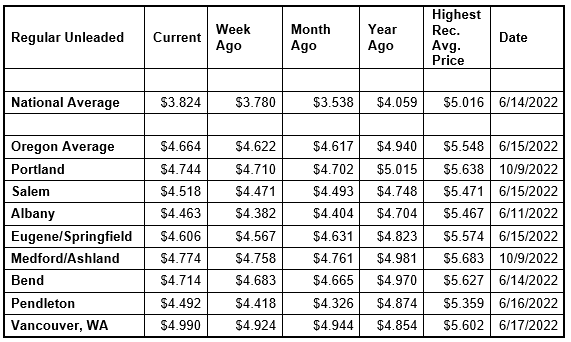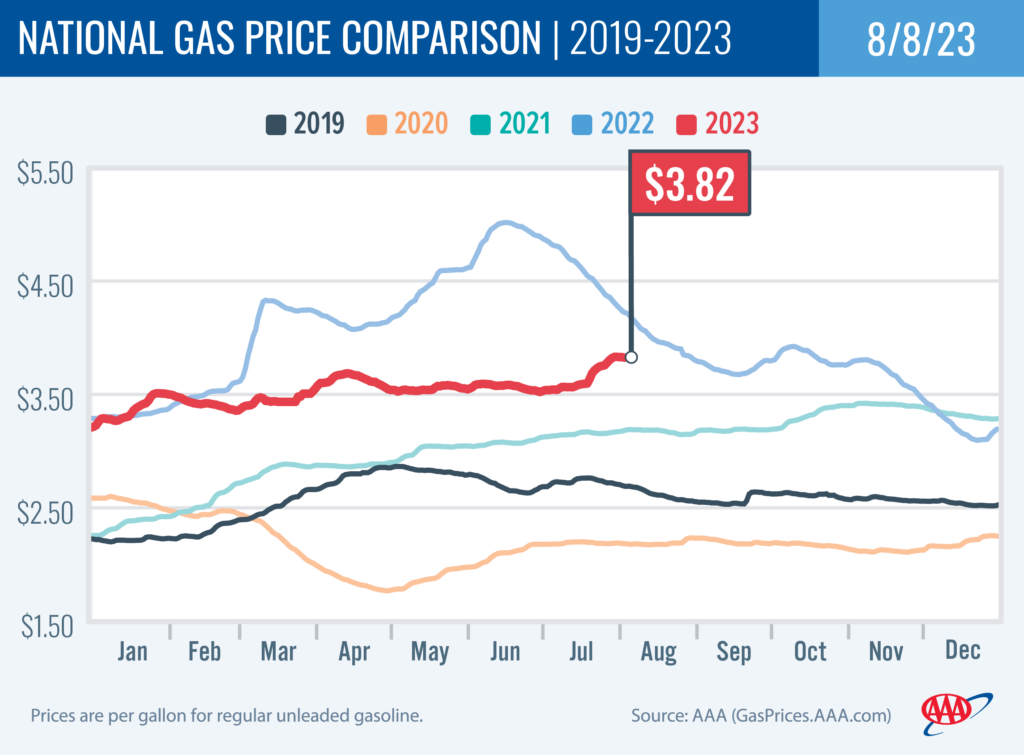PORTLAND, Ore., – Gas prices continue to rise in Oregon and most other states but the rate of increases has slowed. Pump prices climbed this summer due to a rally in crude oil prices and a decrease in refining due to severe heat across much of the U.S. A decrease in demand for gas in the U.S. and increasing supplies are helping to ease rising pump prices. For the week, the national average for regular adds four cents to $3.82. The Oregon average also rises four cents to $4.66.

“Crude oil prices have rallied for the last six weeks. A major factor is the decision from Saudi Arabia to continue its production cuts of one million barrels a day through September 30,” says Marie Dodds, public affairs director for AAA Oregon/Idaho.
Extreme heat across much of the U.S. this summer took its toll on refinery production. When temperatures skyrocket above 100 degrees, refineries can’t operate at peak levels. “They’re working with flammable products that get heated during the refining process. Hot weather also impacts maintenance,” says Dodds. Impacted refineries are returning to more normal operations, boosting gasoline supplies.
Crude oil is trading around $81 today compared to $81 a week ago and $91 a year ago. In July, West Texas Intermediate ranged between about $69 and $82 per barrel. In June, WTI ranged between about $67 and $73 per barrel. In May, WTI ranged between about $63 and $77 per barrel. In April, WTI ranged between about $73 and $83. In March, WTI ranged between about $64 and $81 per barrel. In February, WTI ranged between about $73 and $80 per barrel. In January, WTI ranged between about $73 and $82 bbl. Crude reached recent highs of $123.70 on March 8, 2022, shortly after the Russian invasion of Ukraine, and $122.11 per barrel on June 8, 2022. The all-time high for WTI crude oil is $147.27 in July 2008.
Crude oil is the main ingredient in gasoline and diesel, so pump prices are impacted by crude prices on the global markets. On average, about 47% of what we pay for in a gallon of gasoline is for the price of crude oil, 24% is refining, 14% distribution and marketing, and 14% are taxes, according to the U.S. Energy Information Administration.
Demand for gasoline decreased slightly from 8.94 to 8.84 million b/d for the week ending July 28, according to the U.S. Energy Information Administration (EIA). This compares to 8.54 million b/d a year ago. Meanwhile, total domestic gasoline stocks increased by 1.5 million bbl to 219.1 million bbl. Lower gas demand amid increasing supply will likely help to slow price increases in the days ahead.
Quick stats
Oregon is one of 48 states and the District of Columbia have higher prices now than a week ago. Utah (+ 14 cents) has the largest weekly jump. In all, three states are seeing double-digit increases, compared to 41 states and D.C. a week ago. Colorado (-2/10ths of a cent) is the only state with a weekly decrease. The average in South Carolina is flat.
California ($5.08) has the most expensive gas in the nation for the second week in a row. Washington ($5.00) is second. These are the only two states with averages at or above $5 a gallon. Hawaii ($4.77) is third, Oregon ($4.66) is fourth, Alaska ($4.46) is fifth, Nevada ($4.34) is sixth, Utah ($4.10) is seventh, Illinois ($4.05) is eighth, and Idaho $4.03) is ninth. These are the nine states with averages at or above $4 a gallon, up from seven a week ago. This week 41 states and the District of Columbia have averages in the $3-range. No state has an average in the $2 range this week.
The cheapest gas in the nation is in Mississippi ($3.32) and Louisiana ($3.43). For the 134th week in a row, no state has an average below $2 a gallon.
The difference between the most expensive and least expensive states is $1.76 this week, compared to $1.73 a week ago.
All 50 states and the District of Columbia have higher prices now than a month ago. The national average is four cents more and the Oregon average is five cents more than a month ago. This is the second-smallest monthly increase in the nation. Iowa (+46 cents) has the largest monthly jump. Washington (+4 cents) has the smallest monthly drop.
Oregon is one of 46 states and the District of Columbia with lower prices now than a year ago. The national average is 24 cents less and the Oregon average is 28 cents less than a year ago. Idaho (-77 cents) has the largest yearly drop. Kansas (-2 cents) has the smallest. Washington (+14 cents), Iowa (+12 cents), Georgia (+4 cents) and Florida (+3 cents) are the only states with year-over-year increases. Last year, crude oil prices and pump prices rose rapidly after the Russian invasion of Ukraine.
West Coast
The West Coast region continues to have the most expensive pump prices in the nation with six of the seven states in the top 10. It’s typical for the West Coast to have six or seven states in the top 10 as this region tends to consistently have fairly tight supplies, consuming about as much gasoline as is produced. In addition, this region is located relatively far from parts of the country where oil drilling, production and refining occurs, so transportation costs are higher. And environmental programs in this region add to the cost of production, storage and distribution.
As mentioned above, California has the most expensive gas in the country. Washington, Hawaii, Oregon, Alaska, and Nevada rounding out the top six. Arizona is 13th. Oregon is fourth for the ninth week in a row.
States in the West Coast region are seeing small to moderate increases in gas prices this week. Alaska (+11 cents has the largest weekly gain in the region. Nevada (+3 cents) has the smallest.
The refinery utilization rate on the West Coast fell from 90.9% to 87.6% for the week ending July 28. This rate has ranged between about 73% to 96% in the last year. The latest national refinery utilization rate fell from 93.4% to 92.7%.
According to EIA’s latest weekly report, total gas stocks in the region increased from 28.11 million bbl. to 28.66 million bbl.
A lower refinery utilization rate can put upward pressure on pump prices, while an increase in gasoline stocks can put downward pressure on pump prices.
Oil market dynamics
Crude oil prices remain about $10 per barrel higher than prices at the start of July. Markets continue to be concerned about supply. In addition, the EIA reported that total domestic, commercial crude inventories decreased by 17 million bbl to 439.8 million bbl. – this is the biggest weekly drop on record.
At the close of Friday’s formal trading session, WTI added $1.27 to settle at $82.82. At the close of Monday’s formal trading session, WTI slipped 88 cents to settle at $81.94. Today crude is trading around $81 compared to $81 a week ago. Crude prices are about $7 less than a year ago.
Drivers can find current gas prices along their route with the free AAA Mobile app for iPhone, iPad and Android. The app can also be used to map a route, find discounts, book a hotel and access AAA roadside assistance. Learn more at AAA.com/mobile.

Diesel
For the week, the national average jumps 13 cents to $4.20 a gallon. The record high is $5.816 set on June 19, 2022. The Oregon average adds 11 cents to $4.61. The record high is $6.47 set on July 3, 2022. A year ago the national average for diesel was $5.14 and the Oregon average was $5.85.
Find current fuel prices at GasPrices.AAA.com.
AAA news releases, high resolution images, broadcast-quality video, fact sheets and podcasts are available on the AAA NewsRoom at NewsRoom.AAA.com.
Find local news releases at https://oregon.aaa.com/community/media/media-contacts.html
Fuel prices are updated daily at AAA’s Daily Fuel Gauge at AAA Gas Prices. For more info go www.AAA.com. AAA Oregon/Idaho provides more than 880,000 members with travel, insurance, financial and automotive-related services, and is an affiliate of AAA National, serving more than 63 million motorists in North America.

